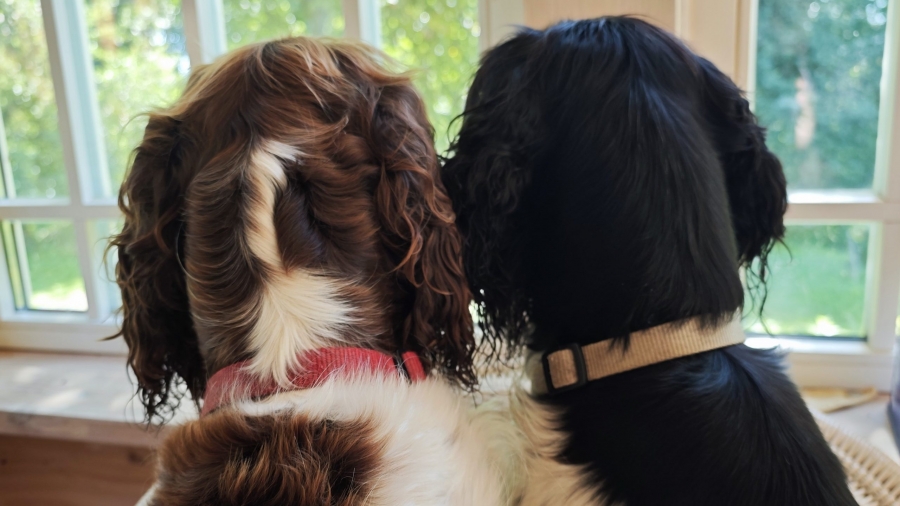My wife, Alma, and I live with two dogs: Ronja and Mona, the English Springer Spaniels. Their antics in our home and the daily errands we run around to care for them frequently stop me in my tracks, prompting deep contemplation about the nature of communication. So when I turn to Lourdes Ortega’s book, Understanding Second Language Acquisition and read the opening line—“Language is one of the most uniquely human capacities that our species possesses”— the hairs on my back stand right up! This writer may know about language, but she clearly hasn’t met our dogs!
Each morning we are rudely awoken either by being jumped on by a 25kg dog, or, worse, by the noisy banging of their tails against the wardrobe next to our bed—no alarm clock needed! As we clamber out of bed, they nudge our hands continually until they have our utmost attention and then they lead us to their leashes, it’s time for walkies! Next, upon returning home, they dash to their metal food bowls and tip them demonstratively against the floor in a cymbal-like crescendo broken only when we fill them up with doggy chow. This is especially effective on a Sunday morning! Finally, when we are wide awake and can no longer sleep, their job is done. They curl up and go back to sleep!
It is with these events in mind that I immediately want to disagree with Ortega’s ‘uniquely human capacities’. The absence of language seems to suggest a state of being left alone and undisturbed – which might be nice once in a while! But maybe it’s me that needs to rethink my understanding of what language is. In an attempt to define it, I carefully begin with “the intended transmission of a message from one being (human, canine or otherwise) to another”. However, realising that language entails something more than, for example the reaction, to the sting of a bee and its received message, I continue “…outside of instinct or natural physical responses’!”
I then decide that language is a tool involving forethought and a desired outcome. When Mona and Ronja see us sleeping too long in the morning, for example, they know that by waking us, and then showing us their leads they will get their walk. Then by tapping their bowls noisily they will get breakfast. I do understand that their actions are instinctive and most likely not the result of strategic planning. Perhaps I am looking at it all from the wrong perspective— rather than seeing their behavior as a step down from spoken language, maybe it’s a step up from the simplistic communication of that bee.
In the first chapter of her book, Ortega goes on to say that ‘Bonobos can achieve the comprehension levels of a two and a half year old human and develop human-like lexical knowledge’. She avoids using the word “language”. This again reminds me think of my dogs. I remember once at a family christening, for instance, when Ronja saw a child leave a plate full of sandwiches on the ground. When no-one, apart from the child, was looking, she gulped down the whole lot. The child then ran to the mum, pointed at the plate and said ‘Mama, woof woof, yum yum’. The message was received and perfectly clear to everyone.
“Assuming the speaker is being co-operative, and not suffering from a brain disorder, we look for the meaning ‘between the lines.’ Scott Thornbury
I struggle to see the difference between these two examples. The latter was an immediate reaction and although the child spoke, she needed no grammar—the sounds she used could have been in any order, and she would still have been understood.
For communication to be recognised as language, more is necessary it seems. For it to be “uniquely human,” as Ortega puts it, it should be regarded as a collection of communicative competences that can be learned and taught to express abstract ideas beyond “the doggy stole my sandwich.” Language, in my opinion, should be something that can be ‘played’ with and used to infer and imply a meaning that can be decoded by the hearer according to the context and the relationships involved. Innate, according to Chomsky, and uniquely human—but even there, I struggle to fully agree.
When Ronja has been naughty and she knows I don’t want to see her, I use the stern Lithuanian expression “dink!” meaning to “go away”, so she does, cowering off to her corner. Other times, when it’s time for a cuddle, I can playfully use the exact same expression and intonation, but of course, not wanting her to go away and she doesn’t. She ignores me and jumps on my lap. Does this suggest that my dog, too, has pragmatic competence?

